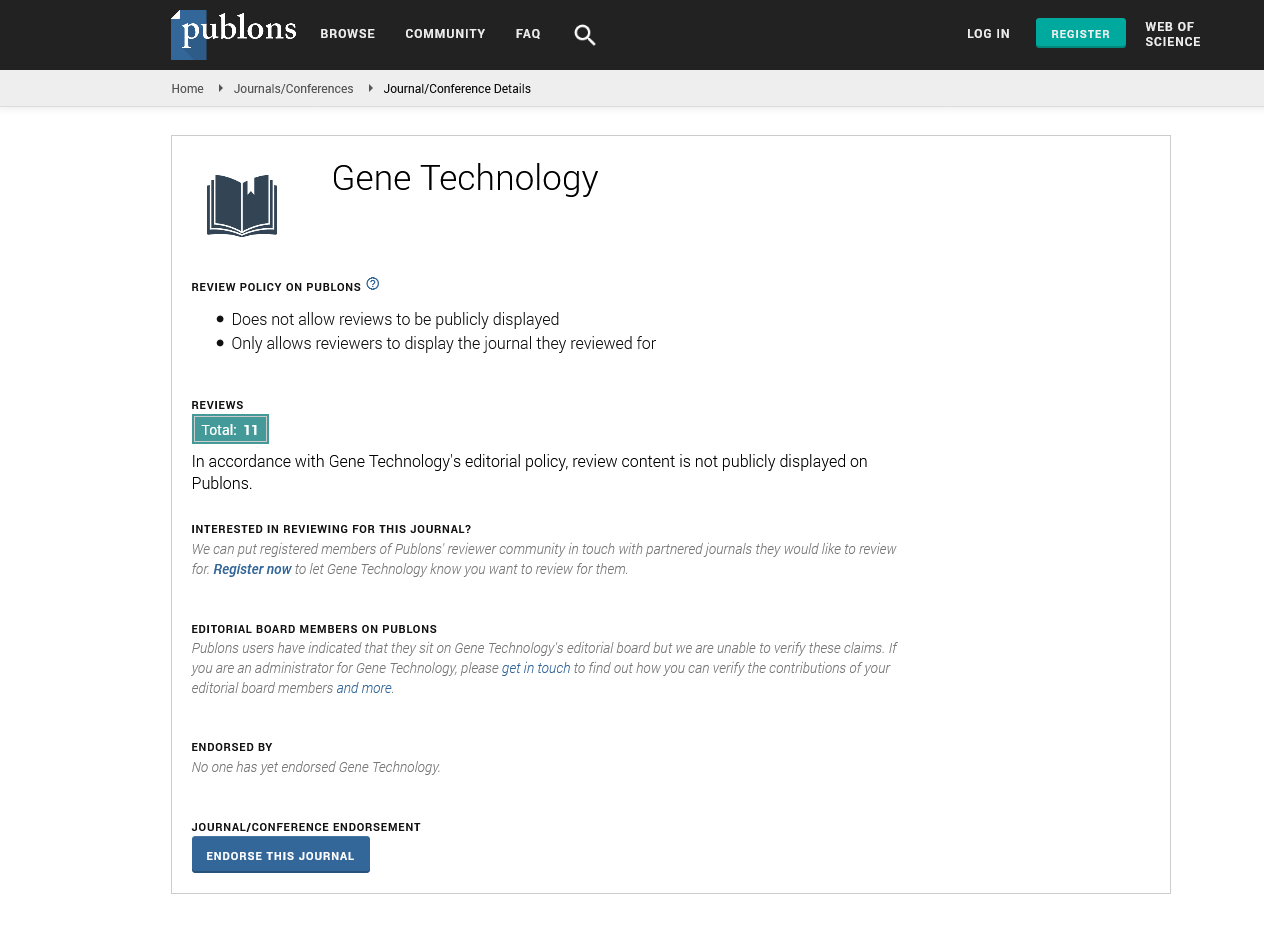Indexed In
- Academic Keys
- ResearchBible
- CiteFactor
- Access to Global Online Research in Agriculture (AGORA)
- RefSeek
- Hamdard University
- EBSCO A-Z
- OCLC- WorldCat
- Publons
- Euro Pub
- Google Scholar
Useful Links
Share This Page
Journal Flyer

Open Access Journals
- Agri and Aquaculture
- Biochemistry
- Bioinformatics & Systems Biology
- Business & Management
- Chemistry
- Clinical Sciences
- Engineering
- Food & Nutrition
- General Science
- Genetics & Molecular Biology
- Immunology & Microbiology
- Medical Sciences
- Neuroscience & Psychology
- Nursing & Health Care
- Pharmaceutical Sciences
Perspective - (2022) Volume 11, Issue 6
Role of MicroRNA Biogenesis Mechanisms of Actions and Circulation
John Brown*Received: 23-Nov-2022, Manuscript No. RDT-22-19236; Editor assigned: 28-Nov-2022, Pre QC No. RDT-22-19236 (PQ); Reviewed: 13-Dec-2022, QC No. RDT-22-19236; Revised: 21-Dec-2022, Manuscript No. RDT-22-19236 (R); Published: 29-Dec-2022, DOI: 10.35248/2329-6682.22.11.208
Description
MicroRNAs, also called miRNAs, are non-coding RNAs that play a key role in regulating how genes are expressed. Most miRNAs are produced via transcription of DNA sequences into primary miRNAs, precursor miRNAs, and then mature miRNAs. However, it has also been noted that miRNAs interact with other areas, such as the coding sequence and gene promoters. MiRNAs can also initiate translation or control transcription under specific circumstances. MiRNA subcellular location, target mRNA abundance, miRNA-mRNA interaction affinity, and other variables all play a role in how dynamically miRNAs interact with their target genes. Exosomes and other vesicles, as well as proteins like Argonautes, can carry miRNAs to target cells once they are discharged into extracellular fluids. Extracellular miRNAs serve as chemical messengers that facilitate communication between cells. An update on the canonical and non-canonical miRNA biogenesis pathways along with the numerous mechanisms behind miRNA-mediated gene regulation are provided in this study. We also provide a summary of the current understanding of extracellular miRNA secretion, transport, and uptake as well as the dynamics of miRNA action.
MiRNAs, or small non-coding RNAs, typically measure 22 nucleotides in length. The majority of miRNAs are produced through the transcription of DNA sequences into primary miRNAs (pri-miRNAs), which are then processed into precursor miRNAs and mature miRNAs. The majority of the time, miRNAs works in conjunction with the 3′ UTR of target mRNAs to inhibit expression. However, it has also been noted that miRNAs interact with other areas, including as the 5′ UTR, coding sequences, and gene promoters. Additionally, it has been demonstrated that under specific circumstances, miRNAs can trigger gene expression. MiRNAs may be transported across several subcellular compartments to regulate the pace of transcription and even translation, according to recent findings.
Biogenesis of miRNAs
RNA polymerase II/III transcripts are processed post- or cotranscriptionally to begin miRNA production. The other miRNAs are intergenic, produced independently of a host gene, and controlled by their own promoters. About half of all currently discovered miRNAs are intragenic and processed primarily from introns and relatively few exons of protein-coding genes MiRNAs are regarded as a family in that context when they are transcribed as a single, protracted transcript known as a cluster which may have connected seed regions. There are canonical and non-canonical pathways for miRNA biogenesis.
MiRNA biogenesis canonical pathway
The canonical biogenesis pathway is the main pathway for processing miRNAs. The microprocessor complex, which consists of the ribonuclease III enzyme and the RNA binding protein DiGeorge Syndrome Critical Region 8, converts primiRNAs from their genes into pre-miRNAs in this pathway (DGCR8). The N6-methyladenylated GGAC and other motifs are found inside the pri-miRNA, which is at the bottom of the unique hairpin structure of pri-miRNA. As a result, pre-miRNA acquires a 2 NT 3′overhang. Pre-miRNAs are produced, and an exportin 5 (XPO5)/RanGTP complex transports them to the cytoplasm where the RNase III endonuclease degrades them. This procedure, which involves the removal of the terminal loop, results in the production of a mature miRNA duplex. The directionality of the miRNA strand affects the name given to the mature miRNA form. The 3′end of the pre-miRNA hairpin produces the 3p strand, whereas the 5′end does the same. The Argonaute (AGO) family of proteins (AGO1-4 in humans) has the ability to ATP-dependently load both strands of the mature miRNA duplex. The proportion of AGO-loaded 5p or 3p strand for any given miRNA may vary from almost equal to primarily one or the other depending on the kind of cell or the cellular environment.
Non-canonical miRNA biogenesis pathways
The non-canonical miRNA biogenesis can generally be divided into Dicer-independent and Drosha/DGCR8-independent processes. The Drosha/DGCR8-independent process generates pre-miRNAs that mimic Dicer substrates. Mirtrons which are created from the introns of mRNA during splicing are an illustration of such pre-miRNAs. Without the need for Drosha cleavage, these developing RNAs are directly exported to the cytoplasm by exportin. Strong 3p strand bias is probably caused by the m7G cap prohibiting Argonaute from loading 5p strands. Drosha, on the other hand, uses endogenous short hairpin RNA (shRNA) transcripts to process Dicer-independent miRNAs. These pre-miRNAs are too short to be Dicersubstrates; hence AGO2 is necessary for them to finish maturing in the cytoplasm. This encourages the loading of the full premiRNA into AGO2 and the 3p strand's slicing under the control of AGO2. Their maturation is finished by the 3′–5′ trimming of the 5p strand.
Mechanisms of miRNA-mediated gene regulation
Additionally, miRNA binding sites have been found in additional mRNA regions, such as the 5′UTR, coding sequence, and promoter regions. While miRNA association with the promoter region has been reported to increase transcription, miRNA binding to the 5′UTR and coding areas has been shown to silence the expression of certain genes.
Citation: Brown J (2022) Role of MicroRNA Biogenesis Mechanisms of Actions and Circulation. Gene Technol. 11:208.
Copyright: © 2022 Brown J. This is an open access article distributed under the terms of the Creative Commons Attribution License, which permits unrestricted use, distribution, and reproduction in any medium, provided the original author and source are credited.

